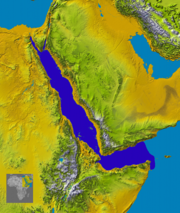
The Old World flycatchers are a large family, the Muscicapidae, of small passerine birds restricted to the Old World, with the exception of several vagrants and two species, bluethroat and northern wheatear, found also in North America. These are mainly small arboreal insectivores, many of which, as the name implies, take their prey on the wing. The family is relatively large and includes 351 species which are divided into 54 genera.

Serinus is a genus of small birds in the finch family Fringillidae found in West Asia, Europe and Africa. The birds usually have some yellow in their plumage. The genus was introduced in 1816 by the German naturalist Carl Ludwig Koch. Its name is Neo-Latin for "canary-yellow".

The genus Carduelis is a group of birds in the finch family Fringillidae.

The Siberian blue robin is a small passerine bird that was formerly classified as a member of the thrush family, Turdidae, but is now more generally considered to belong to the Old World flycatcher family, Muscicapidae. It and similar small European species are often called chats. Recent research suggests that this species and some other East Asian members of Luscinia should be classified in a new genus, together with the Japanese and Ryūkyū robins. The genus name Larvivora comes from the Neo-Latin larva meaning caterpillar and -vorus meaning eating, and cyane is Latin for "dark-blue".
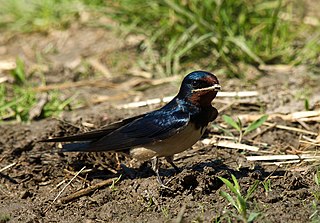
The bird genus Hirundo is a group of passerines in the family Hirundinidae. The genus name is Latin for a swallow. These are the typical swallows, including the widespread barn swallow. Many of this group have blue backs, red on the face and sometimes the rump or nape, and whitish or rufous underparts. With fifteen species this genus is the largest in its family.
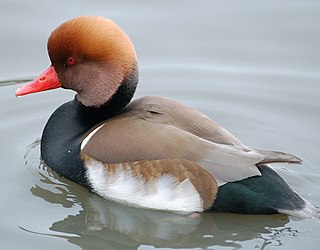
Netta is a genus of diving ducks. The name is derived from Greek Netta "duck". Unlike other diving ducks, the Netta species are reluctant to dive, and feed more like dabbling ducks.

Anthochaera is a genus of birds in the honeyeater family. The species are endemic to Australia and include the little wattlebird, the red wattlebird, the western wattlebird, and the yellow wattlebird. A molecular phylogenetic study has shown that the regent honeyeater also belongs in this genus.

Nannopterum is a genus of cormorant comprising three species. They are found throughout the Americas, hence the common name American cormorants.

Actitis is a small genus of waders, comprising just two very similar bird species.

The orange-throated tanager is a species of bird in the tanager family Thraupidae that is found very locally in humid forests around the Ecuador-Peru border. As a species it is considered threatened. The orange-throated tanager is the only member of the genus Wetmorethraupis, named after the ornithologist Alexander Wetmore. It is closely related to members of the genus Bangsia.
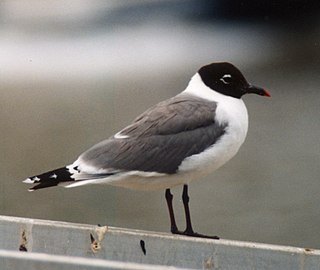
Leucophaeus is a small genus of medium-sized New World gulls, most of which are dark in plumage, usually with white crescents above and below the eyes. They were placed in the genus Larus until recently. The genus name Leucophaeus is from Ancient Greek leukos, "white", and phaios, "dusky".

Parus is a genus of Old World birds in the tit family. It was formerly a large genus containing most of the 50 odd species in the family Paridae. The genus was split into several resurrected genera following the publication of a detailed molecular phylogenetic analysis in 2013. The genus name, Parus, is the Latin word for "tit".

Pytilia is a genus of small brightly coloured seed-eating birds in the family Estrildidae. They are distributed across Africa.

Tanygnathus is a genus of parrots in the Psittaculini tribe, of the superfamily of Psittacoidea.

Chroicocephalus is a genus of medium to relatively small gulls which were included in the genus Larus until recently. Some authorities also include the Saunders's gull in Chroicocephalus. The genus name Chroicocephalus is from Ancient Greek khroizo, "to colour", and kephale, "head".

The greenfinches are small passerine birds in the genus Chloris in the subfamily Carduelinae within the Fringillidae. The species have a Eurasian distribution except for the European greenfinch, which also occurs in North Africa.

Crithagra is a genus of small passerine birds in the finch family (Fringillidae). They live in Africa and Arabia.

Microcarbo is a genus of fish-eating birds, known as cormorants, of the family Phalacrocoracidae. The genus was formerly subsumed within Phalacrocorax.
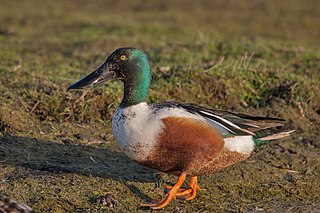
Spatula is a genus or subgenus of ducks in the family Anatidae that includes the shovelers, garganey, and several species of American teals.

Orochelidon is a genus of birds in the swallow family Hirundinidae. These species are resident in the Andes Mountains of South America.









